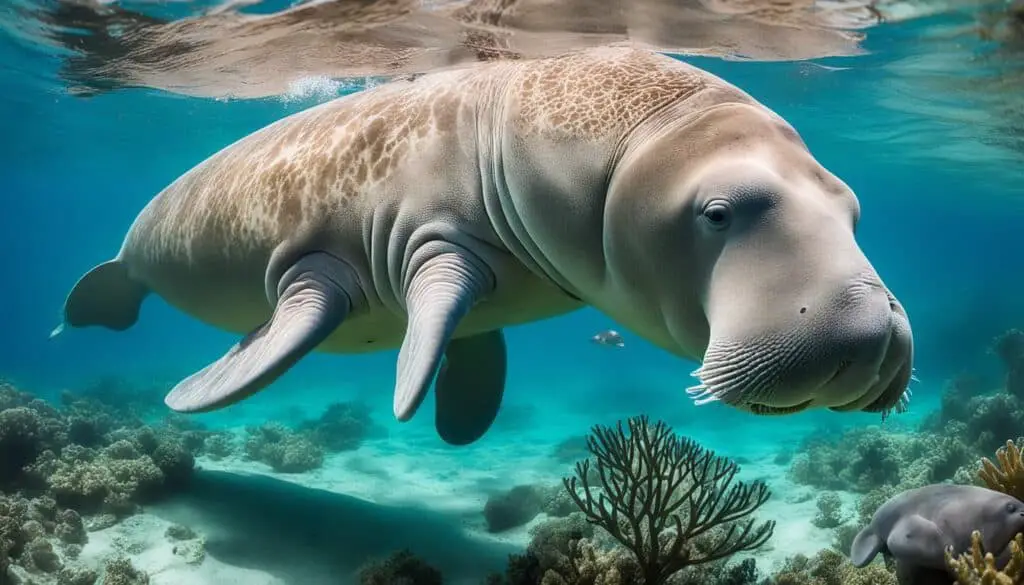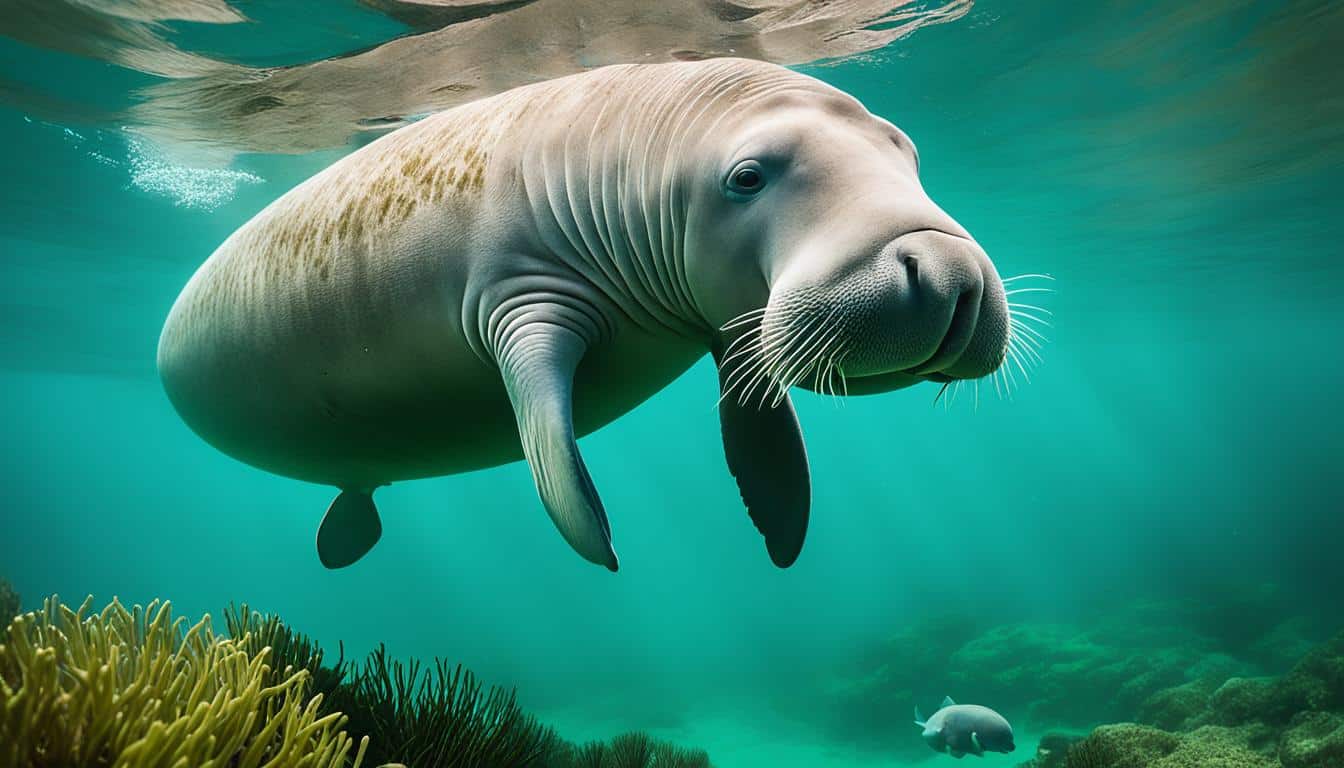Dugongs, known as “sea cows,” are fascinating marine mammals. They show amazing parenting behavior. It’s crucial to know how they care for their young to help protect them and appreciate these gentle creatures. Female dugongs spend a lot of time and effort with their calves, showing strong maternal bonding.
Learning about dugong calf care shows how important the mother is to her calf’s growth. She guides and protects her young from the start. She teaches them how to eat and survive in the water.
Understanding Dugongs and Their Habitat
Dugongs are fascinating marine mammals that play a key role in marine ecosystems. They have unique traits and live in specific places. Knowing about their characteristics and where they live helps us understand their needs.
Dugong Characteristics
Dugongs, also known as Dugong dugon, are big and eat plants. They are about nine feet long and weigh between 550 to 1,000 pounds. Their bodies are made for the ocean, with a special tail and a nose that helps them find food in seagrass beds.
This diet is crucial for their survival and helps keep the ocean healthy. By learning about dugongs, we see how important they are to the ocean.
Habitat Preferences
Dugongs live in calm, shallow waters near seagrass beds. These areas are key for their survival because they offer food and shelter. They rarely go into rivers, showing they are truly ocean animals.
Their home is closely tied to the health of seagrass ecosystems. These areas feed them and are important for many other sea creatures too.
| Characteristic | Description |
|---|---|
| Species | Dugong dugon |
| Size | Averages 9 feet in length |
| Weight | Between 550 to 1,000 pounds |
| Diet | Herbivorous, primarily seagrasses |
| Habitat | Shallow coastal waters, seagrass beds |
| Swimming Adaptations | Streamlined body, fluked tail |
Breeding and Reproductive Behavior
Dugongs have interesting ways of breeding, with unique behaviors and rituals. These habits help us understand their life cycle and their role in the ecosystem.
Breeding Age and Cycle
Dugongs become ready to breed between six and seventeen years old. After that, females have a calf every three to seven years. They carry their babies for 13 to 15 months. They don’t move to special places to breed, showing a stable cycle in their home.
This steady breeding helps keep their numbers stable in their habitats.
Mating Rituals
The way dugongs mate is quite interesting. They can mate all year, with males being very competitive to get the females’ attention. They fight and make sounds to attract the females in heat. These rituals are key to their mating success and show how important social life is for them.

How do dugongs care for their young?
Dugong mothers play a key role in helping their young grow strong. They teach their calves important survival skills. This care is crucial for the calves to survive and thrive in the ocean.
Maternal Bonding
Right after birth, a mother dugong and her calf start bonding. This bond is important for both their emotional and physical health. The calf, about 30 kg, depends on its mother for everything.
The mother keeps her calf safe and shows it the ropes of the ocean. This makes the calf feel secure in its new world.
Nursing and Feeding Education
The mother and calf bond even more during nursing, which lasts up to 18 months. The mother teaches her calf how to find and eat seagrasses, their main food. The calf watches and copies its mother’s eating habits.
This learning period is key for the calf’s growth and future independence. It gets both food and important life skills from its mother.
Dugong Calf Care Strategies
Dugong calves face many dangers early on. Mothers use special ways to keep them safe. These strategies help the calves grow and learn important skills.
Calf Safety and Protection
Mothers are always watching out for their calves. They keep them close to avoid dangers like sharks and killer whales. Here are some ways they protect their young:
- Swimming in safe spots to stay away from danger.
- Using their bodies to shield the calves from threats.
- Keeping a close eye on their calves at all times.
Extended Learning Period
The learning period for dugong calves lasts about six years. It’s crucial for their growth. During this time, mothers teach them important things like:
- How to find food.
- Exploring their home.
- How to interact with other dugongs.
By teaching and protecting their calves, dugongs help them become strong and ready for life. This approach builds resilience and adaptability against nature’s challenges.
Dugong Family Dynamics
Dugong family dynamics are key to their well-being. At the core is the deep bond between mothers and their calves. They stay close while swimming and feeding, creating a nurturing space. This is vital for the young to learn survival skills.
Mother-Infant Interaction
The bond between a dugong mother and her calf is both instinctual and interactive. The calf often looks for close contact with its mother. This strengthens their bond. It’s crucial as the calf relies on the mother for food and safety early on.
The mother teaches her young important survival skills. This ensures they can survive in their environment.
Social Structures
Dugongs are mostly alone but come together during mating seasons. Mothers focus on their young but may meet other dugongs then. These meetings are important for breeding and for the young to learn from others.
Understanding dugong family dynamics helps conservationists protect them and their homes.
FAQ
How do dugongs care for their young?
Dugongs show unique parenting habits, with a strong focus on mother-calf bonding and detailed calf care. They nurse their young for up to 18 months. During this time, mothers teach them how to find food and survive.
What does maternal bonding look like in dugongs?
Right after birth, dugong mothers and their calves start bonding closely. The calf stays near its mother for safety and to learn by watching. This close relationship is key to the calf’s growth.
How does a dugong mother nurse her calf?
Dugong mothers feed their calves underwater, as newborns weigh about 30 kg. This nursing lasts up to 18 months. It helps the mother feed and teach the calf how to forage.
What strategies do dugong mothers use for calf safety?
Mothers keep their calves close and protect them from dangers like sharks or killer whales. This careful management helps keep the calf safe.
How long does the learning period last for dugong calves?
Dugong calves learn for up to six years before becoming independent. They slowly gain skills in finding food and navigating their environment with their mothers’ guidance.
What does the mother-infant interaction entail for dugongs?
Mothers and calves spend a lot of time together, swimming and feeding. This helps the calf learn important survival skills in a safe environment.
Are dugongs social animals, and how does this affect their family dynamics?
Dugongs are mostly alone but come together during mating. Mothers raise their young alone, focusing on their bond and teaching them survival skills.







